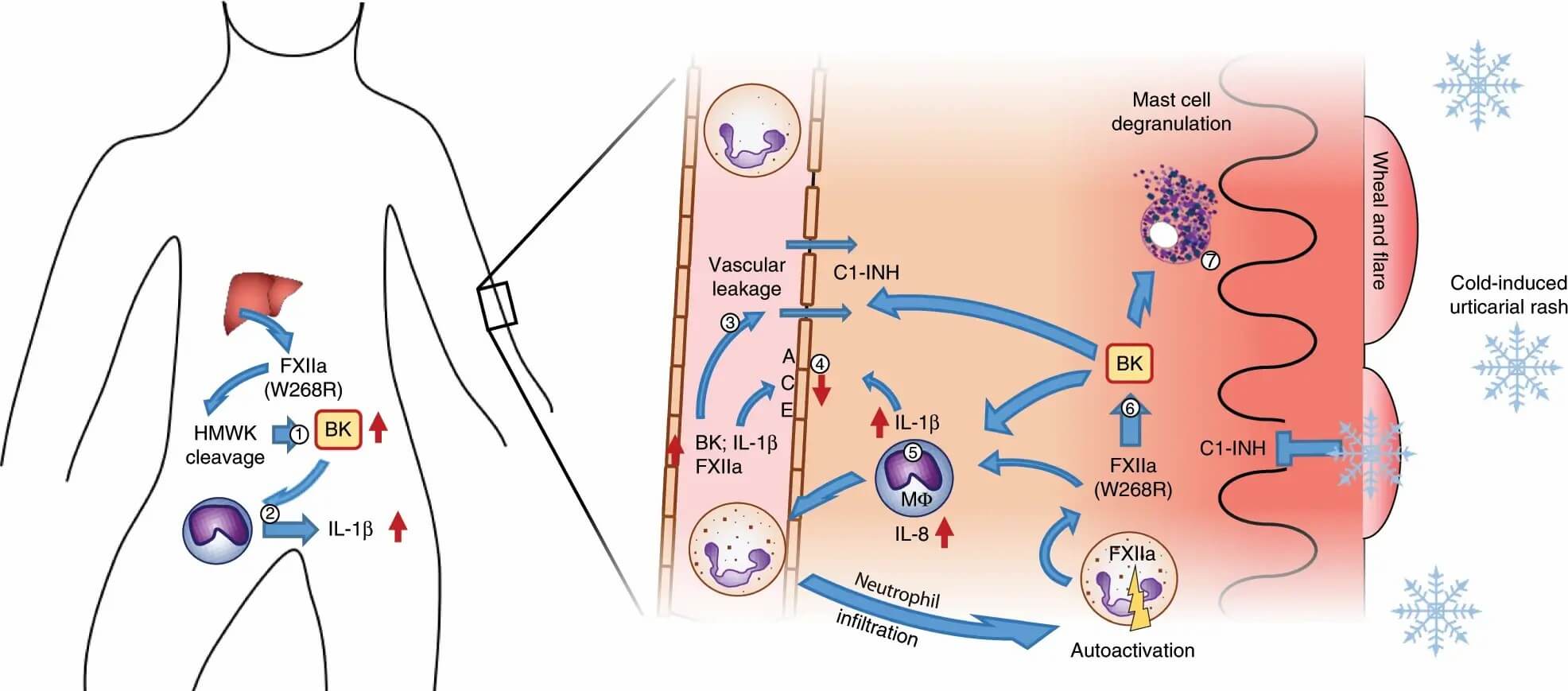Cold Urticaria
Cold urticaria is a rare condition that causes an allergic reaction to cold temperatures. With our company's profound expertise in cold urticaria research, we are well-equipped to offer tailored solutions and comprehensive support to facilitate your research process from cold urticaria therapy development to therapy commercialization.
Overview of Cold Urticaria
Cold urticaria, also known as cold hives, is a medical condition characterized by the formation of welts or hives on the skin after exposure to cold stimuli. It is an allergic reaction to low temperatures and can cause discomfort and itching. The annual incidence of cold urticaria is reported to be 0.05%.
 Fig. 1 Proposed pathogenesis underlying FXII W268R mutation in familial cold autoinflammatory syndrome (FCAS). (Scheffel, Jörg, et al., 2020)
Fig. 1 Proposed pathogenesis underlying FXII W268R mutation in familial cold autoinflammatory syndrome (FCAS). (Scheffel, Jörg, et al., 2020)Pathogenesis of Cold Urticaria
Cold urticaria is primarily caused by a histamine reaction triggered by exposure to cold stimuli, such as a drop in temperature, cold air, or cold water. The exact mechanisms underlying this condition are not completely understood, but several factors contribute to its pathogenesis.
- Mast Cell Activation
Upon exposure to cold temperatures, mast cells in the skin release histamine and other inflammatory mediators, leading to the characteristic hives and itching. - Immunological Factors
Cold-induced skin changes can trigger an immune response, activating specific immune cells and releasing pro-inflammatory substances, which worsen symptoms.
- Genetic Predisposition
Familial cold urticaria is caused by mutations in the CIAS1/NALP3 gene, which is involved in regulating the immune system. - Other Factors
Secondary cold contact urticaria involves abnormal serum proteins and is often accompanied by other symptoms like Raynaud's phenomenon or purpura.
Strategies of Cold Urticaria Therapy Development
Targeting Histamine Receptors
Targeting histamine receptors, particularly the H1 receptor, has shown promise in mitigating the symptoms associated with cold urticaria. Antihistamine drugs, such as cetirizine and fexofenadine, are commonly used to block the effects of histamine and alleviate itching and hives.
Modulating Immune Response
Immune modulators have emerged as potential therapeutics for cold urticaria, focusing on regulating the immune system. Drugs like omalizumab and cyclosporine have been investigated for their ability to modulate the immune response and alleviate the frequency and intensity of hives.
Our Services
Our company leads the way in rare disease research and therapeutic development. Our experienced team of scientists and researchers is committed to unraveling the intricacies of cold urticaria and other rare diseases through the creation of advanced research platforms.
Research Platforms of Cold Urticaria
Utilizing cutting-edge technology, we aim to strategize and develop diagnostics for cold urticaria to promote early identification and accurate diagnosis of the disease. With the establishment of cold urticaria animal models and comprehensive investigations into disease mechanisms and targets, we possess the capacity to develop therapeutic drugs for cold urticaria, thereby facilitating safety evaluation and pharmacokinetic studies of drug candidates.
Animal Models of Cold Urticaria
| Induced Models | |||
| The development of animal models for cold urticaria involves inducing similar symptoms to those observed in human patients. Researchers typically expose animals to cold stimuli and monitor the resulting reactions on the skin. This can be achieved through various methods, such as cold water immersion, cold air exposure, or direct contact with cold surfaces. The severity and duration of exposure can be adjusted to mimic the range of symptoms seen in humans. | |||
| Genetically Engineered Models | |||
| We specialize in modifying an organism's genetic makeup to mimic specific aspects of a human disease or condition through advanced genetic engineering techniques. Our scientists have successfully constructed gene knockout and transgenic models of cold urticaria to edit or introduce foreign genes or genetic elements into the organism's genome. | |||
| Optional Models |
|
|
|
| Optional Species | Mice, Rats, Guinea Pigs, Rabbits, Dogs, Others | ||
Regardless of your current research stage, we offer comprehensive research services tailored to your needs. If you are interested in our services, please don't hesitate to contact us for more information and a detailed quotation regarding the specific services you require.
References
- Scheffel, Jörg, et al. "Cold-induced urticarial autoinflammatory syndrome related to factor XII activation." Nature Communications 11.1 (2020): 179.
- Prosty, Connor, et al. "Prevalence, management, and anaphylaxis risk of cold urticaria: a systematic review and meta-analysis." The Journal of Allergy and Clinical Immunology: In Practice 10.2 (2022): 586-596.
All of our services and products are intended for preclinical research use only and cannot be used to diagnose, treat or manage patients.
